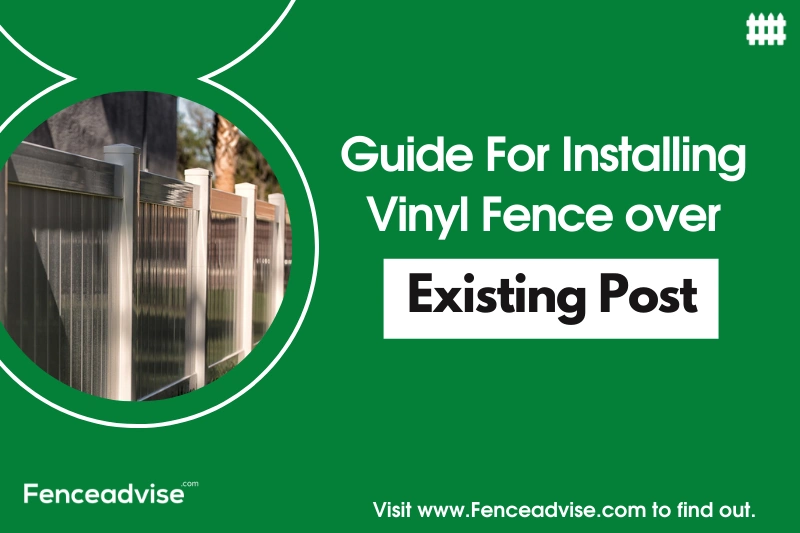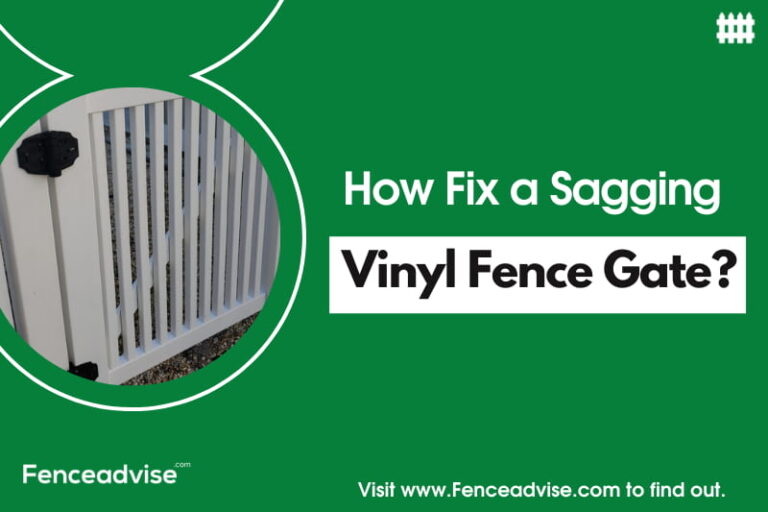We include products we think are useful for our readers. If you buy through links on this page, we may earn a small commission. Read our affiliate disclaimer here.
As a proud fence owner with a dream of enhancing my property’s charm, the idea of installing a vinyl fence over existing posts intrigued me. This guide serves as a valuable resource for fellow homeowners on a budget-friendly DIY journey.
No longer reliant on expensive contractors, this comprehensive guide unfolds the essential steps, insights, and tools needed for a successful vinyl fence installation.
From determining post height to weaving panels and ensuring durability, the guide navigates through the intricate process, allowing homeowners to transform their surroundings into a cozy haven.
How to Build a Fence with Existing Posts?
Elevens 48" W X 48" H Privacy Screen Outdoor Privacy Fence
If your existing fence needs replacing but you don’t want to spend a fortune on new fencing material, you might be tempted to try building a fence over existing posts.
To build a fence over existing posts, you’ll need to follow these steps:
1. Determine Post Height:
- Before starting your project, accurately measure the height of your existing posts. This initial measurement is crucial as it sets the foundation for the entire fence.
2. Measure Fence Length:
- Once the post height is determined, measure the length of the area you want to enclose with the vinyl fence. This step helps you calculate the number of vinyl panels required for the entire span.
3. Post and Wire Setup:
- Install vinyl posts at regular intervals along the desired fence line. Ensure a minimum of 5 posts for stability. String wire tightly between the posts, creating a guide for attaching the vinyl panels. This step is essential for maintaining uniformity.
4. Panel Installation:
- Attach vinyl fencing panels to both sides of the fence by weaving them through the rows of wire. This creates a secure and visually appealing structure. Ensure the panels are snug to maintain stability.
5. Securing the Panels:
- Staple any loose ends of the vinyl panels to the posts. This step adds an extra layer of security, preventing the panels from shifting or becoming loose over time.
6. Optional: Vinyl Panels with Caps:
- For a more streamlined look, consider using vinyl fencing panels with caps. Cut the panels to match the post height, wrap them around the posts, and secure them with screws. This alternative offers both aesthetic appeal and durability.
7. Leveling:
- Use a level throughout the installation process to ensure the fence is straight and level. Proper leveling guarantees a visually pleasing result and enhances the overall integrity of the fence.
8. Finishing Touches:
- Trim any excess material from the vinyl panels for a clean and polished appearance. Confirm that all panels are securely fastened to the posts, addressing any loose ends or potential weak points.
Here are simple instructions on how to make caps for your posts using vinyl panels.
- Measure the height of each post. Cut panels to this size.
- Wrap caps around posts starting at top, bending over to the bottom, stretching around sides to a 45-degree angle, and back up to the top.
- Drill screws through the panels into posts.
Remember that if you are working with an existing fence, you’ll need to make sure that your posts are sturdy enough for new fencing panels.
Can you Install a Vinyl Fence with a Metal Post?
It is not advisable to install a vinyl fence with a metal post because it will be too heavy for the frame and may cause damage.
One way to solve this problem is by adding additional framing below the rail. Make sure that it also has sufficient load-bearing capacity by installing all of the above mounting rails before you lay your vinyl fence panels into place. If your existing posts are made out of concrete or steel, you can use them for this purpose.
Find the right fence contractor for your project
How to Install Vinyl Fence Over Existing Metal Posts?
In order to install a vinyl fence over an existing metal post, you’ll need to follow these steps:
1) Install posts in holes, leaving 5 to 6 inches above ground level. Be sure to install fence post anchors when you are doing this step.
2) Use concrete reinforcements to provide the fence with extra support and durability.
3) Add the new posts and install them at least 12 inches into the ground. Be sure to screw the caps and plates on tightly so your fence will be sturdy and secure.
4) Fill in with dirt and create a mound around the post base. This will make it easy to cut the next fence rail you require. Add rocks if desired.
5) Prepare for the vinyl installation by cutting fence panels to size. Measure the distance between posts using a measuring tape. Cut fence rails to the desired length and install them on top of concrete reinforcements or mounds.
6) Attach paneling by aligning panel openings to mounting rails on posts, then slip-clipping rail clamps over post flanges. Apply pressure until clips automatically lock into place.
Get Matched with Local Fence Professionals
Answer a few questions and we’ll put you in touch with pros near you.
Read More
- How to prevent mold on vinyl fence?
- How long does vinyl fence last?
- How to Clean Bird Poop off Vinyl Fence?
How to Attach a Vinyl Fence to a Wood Post?
Attach a vinyl fence to the wood post by drilling a pilot hole through the vinyl and, from below, attach a hardware chain or metal clips with screws to hold it in place.
Here is the step-by-step process for attaching a vinyl fence to a wood post:
STEP 1: PREPARE POSTS FOR FENCE INSTALLATION
– Alternatively, you can purchase “L” brackets to attach the fence to the wood post.
– Use a round file to remove any sharp edges on the top of the posts where they meet together.”
STEP 2: MEASURE AND MARK THE POSITION OF THE FENCE ON POSTS FOR DRILLING HOLE.
– Measure and mark position for fencing with pencil or pen at each end of each fence section.
– Measure your post spacing to determine how far apart to place the holes at each end of the fence sections.
– Space posts are approximately 10″ apart for 4×4 posts or 12″ apart for 6×6 posts.
STEP 3: DRILL HOLES IN POSTS FOR ATTACHING TO THE FENCE
– Using a 1/8″ drill bit, drill holes through posts at marked locations.
– Drill holes about 3/4″ deep into the posts.
– If posts are not marked, determine proper spacing for fence sections before drilling any holes in posts.
STEP 4: PREPARE FENCE FOR INSTALLATION ON DRILLED POSTS
– Place the fence onto posts and layout vinyl pieces on top of each section that will be joined for seams.
– Overlap the edges of each section by at least 6″ to make it easier to match the seam pattern when you are not able to match up exact ends when butting sections together.
STEP 5: ATTACH FENCE TO DRILLED POSTS
– Drill holes for attachment of clips or hardware chains using 1/8″ drill bit.
– Position fence sections on top of marks on posts and attach the fence to the drilled holes with metal clips, and clamping screws.
STEP 6: TIGHTEN METAL CLIPS OR CLAMP SCREWS TO SECURE FENCE ON POSTS.
– Using a screwdriver tightens metal clips or clamp screws to secure fencing on posts.
STEP 7 – IF NECESSARY, USE A STEP STOOL TO ATTACH ENDS OF FENCING TOGETHER OVER SEAMED SECTIONS.
– This is optional but it does help to hold the vinyl in place while you line up the ends for attachment.
Talk to a Fence Contractor Near You
How Can you Install Vinyl Fences Over Existing Chain Link Posts?
In order to install a vinyl fence over existing chain link posts, you will need to buy new pots and set these into the ground. The reason for this is that vinyl will not “stick” to the current posts. Vinyl is also very heavy and it should be installed on its own posts at least 20 inches deep.
Here are the steps to install vinyl fence over existing chain link posts:
1) Remove or cut away any hardware and attachments from the chain-link posts.
2) Clean off surface rust with sandpaper and/or a wire brush and remove all debris.
3) Coat post with primer, then paint the desired color on PVC vinyl fences only.
4) Using special bonding adhesive for vinyl fences, attach rails at top of vinyl fence to end of the post (minimum 12″ overlap).
5) Install the base cap over the top of PVC fence rails attached to an old post.
6) Place included short cap spacer on top of the second pole connected to old post so it sticks about 2-3″ out from metal railings at the bottom edge. Place a long cap spacer next to the last pole connected to the old post (must be longer than the short spacer).
7) Cut the vinyl fence to the desired length. Attach rails on new posts to the pre-installed railings on old posts with vinyl fence adhesive or screws (minimum 12″ overlap).
8) Install end caps on the end of each PVC fence section. When finished, remove old posts.
Can you Mix Vinyl and Wood Fencing?
fence advise editor’s choice
Elevens 48″ W X 48″ H Privacy Screen Outdoor Privacy Fence Panels
Yes, Mixing vinyl and wood fencing can be a creative choice for homeowners seeking a unique aesthetic. While feasible, it requires careful planning to ensure compatibility in terms of materials, design, and maintenance.
Both materials have distinct characteristics, with vinyl offering low maintenance and wood providing a natural look.
However, differences in durability and upkeep may pose challenges over time. Proper installation and consideration of long-term maintenance needs are vital.
The result can be a visually interesting and harmonious fence that combines the benefits of both materials, catering to individual preferences and practical considerations for an appealing and distinctive property enclosure.
At FenceAdvise, we pride ourselves on being the most reliable and trustworthy source of fencing information. Our articles are based on only the highest quality sources, including peer-reviewed studies, to ensure that our readers always have access to accurate information. Read more about our Editorial Guidelines, About Us.






